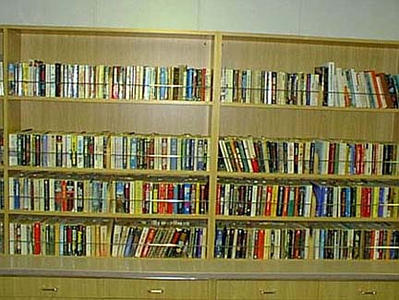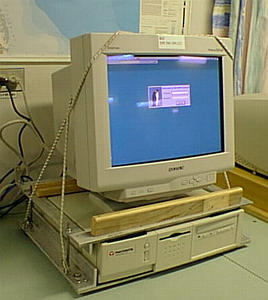23 March, 1999
March 23, 1999
Hi from the Nathaniel B. Palmer! We've had a great day for continuing our
travels across the Drake Passage -- the winds were light, the sun was out,
the sky was blue, and the waves were minimal. This afternoon, Julia even
took me outside to show me a great rainbow. We are so fortunate to have
such a good crossing from Antarctica to South America. Vladimir says that
he's seen one crossing that was calmer . . . and that was in 1994. Of
course, we've had some waves; after all, we're in the open ocean.
Yesterday, we had waves comparable to some of our worst days in Antarctica
(over 20 feet) . . . which are referred to as an average day in the Drake
Passage. Today, however, the seas are calmer with waves closer to 6 feet
in height. The winds are starting to pick up this evening, but we should
be far enough north by the time the next storm comes through that we will
be protected by the land. John and Peter did a great job of deciding when
we should leave Antarctica in order to squeeze in-between two low pressure
systems.
So, let's look at the first of yesterday's questions, "Why is the Drake
Passage known for commonly having very rough seas?" There are actually two
parts to this answer: the first has to do with the ocean currents, and the
second has to do with the atmosphere. If you look at a globe, you will
notice that there are no continental land masses to block ocean circulation
at 60 degrees South latitude. This means that the ocean currents circle
the entire globe in this location. The ocean waters move from the west to
the east, and this current is called the West Wind Drift. The Drake
Passage is the narrowest place for the waters to pass between two
continents throughout this entire latitude. As the large volume of water
squeezes through such a narrow passage, the speed of the current
intensifies.
The winds between about 30 degrees and 60 degrees South latitude are
primarily from the west . . . belonging to a wind belt known as the
Westerlies. These winds actually drive the West Wind Drift that we have
already mentioned. These winds tend to be the strongest in the austral
autumn and austral spring. In addition, there is a large zone of storm
formation and intensification that can be found at about 50 degrees South
latitude. These storms are frequent all year long, but during the winter
their frequency increases. We have seen one low pressure system after
another throughout our entire trip. Most of these storms have formed in
this location and moved gradually southward under the influence of the
westerlies. Of course, storms cause the winds and the waves to be higher
than normal. Frequent storms in the Drake Passage cause very high waves
for many of the voyages across these waters.
Now, let's look at our second question for today, "What kinds of things
should be done on a ship in order to deal with such conditions?" As you
already know, we can have very high waves without ever seeing the Drake
Passage (see the journal on March 2). Ships have to be built with this in
mind, and the Nathaniel B. Palmer is no exception. To begin with, all
equipment and gear is strapped down. Boxes of cargo have large straps to
make sure that they don't move around with the rocking of the ship. Many
large items are actually bolted to the deck. Even the anchor has a steel
cable around it, and the lifeboats have straps (with easily removable
hooks) that keep the boats from swinging while they are suspended from the
side of the ship.
For our personal comfort and safety, there are many other precautions.
There are handrails that line every hallway and set of stairs. We also
have a handrail in each of our showers. We even have a bar across our beds
to keep us from rolling out while we are sleeping. In the galley, there
are removable metal plates that can be placed around the burners to make
sure that pots stay on the stove. In really bad seas (which we haven't
seen on this trip), they galley doesn't even cook hot meals . . . except
for maybe warming up some soup. Also, our tables have side rails that can
be locked in place to help keep plates on the tables. The condiments in
the center of each table are secured in a wooden rack that's bolted to the
table. Both the tables and the chairs in the mess (where we eat) are also
bolted to the floor.
Velcro is also a popular way to secure lighter items. Most of the
telephones that are hanging on the walls have the receiver held to the
phone with velcro. Trash cans are strapped to a more stable item such as a
cabinet or pole. On the bridge, the trash can is tied to the side of a
drinking fountain (which is, in turn, bolted to the wall). In the 02
Lounge (with the large television and the video library), all of the videos
are in racks to prevent them from spilling onto the floor. In the 03
Conference room (where the library is located), all of the books are also
in shelves that have metal rails to keep the books in place.
The outside doors are also made to protect the ship from the water that
sometimes crashes on the decks with high waves. The doors are very heavy,
with several latches around the perimeter to make sure that the door is
securely shut. Rubber gaskets provide a watertight seal around the door
itself. In order to get in or out of a door, you must step up and over a
threshold that is nearly a foot high (this prevents water from constantly
sloshing against the bottom part of the door and its seal). In really
rough seas, you aren't even allowed to go outside on the decks -- not that
you would want to go out in those conditions!
Well, we have one more day in the Drake Passage, and then we will be
entering the Strait of Magellan from the eastern coast of South America and
heading west toward Punta Arenas. That should happen sometime in the
early morning of the 24th (about 30 hours from now). We've been traveling
very quickly as a result of the good weather and calm seas. That just
means we'll have a few extra hours to spend in Chile before returning home!
Two days ago, I saw both Gentoo and Chinstrap penguins. How are they
different from the Emperors and Adelies that I saw earlier in my
expedition? We'll find out tomorrow. See you then!
Kim Giesting
Latitude: 55 degrees 39 minutes South
Longitude: 64 degrees 45 minutes West
Temperature: 5.2 degrees Celsius
Barometer: 995.2 mb
Wind Speed: 35.1 knots
Wind Direction: 206 (from the Southwest)
Sunrise: 07:20
Sunset: 19:27

The bookshelves have a metal rail in order to keep the books from falling out.

Computers are strapped down in order to make sure that they don't fall off the counters in rough seas.

The outside doors are made to protect the ship from the water that sometimes crashes on the decks with high waves. Also, notice the handrails that are attached to the walls.
Contact the TEA in the field at
.
If you cannot connect through your browser, copy the
TEA's e-mail address in the "To:" line of
your favorite e-mail package.
|
